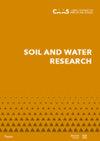从智利中部Puchuncavi(El Melón和Puchuncawi地区)农业土壤中分离的腐殖物质的13C-NMR光谱
IF 1.7
4区 农林科学
Q4 SOIL SCIENCE
引用次数: 2
摘要
智利是一个农业发达的国家,农业土壤面临着Cu、Cd、Pb和Zn等金属以及类金属(as)污染的问题。这些元素可以通过不同的机制被土壤保留,即与有机质形成复合体或被有机质包裹。这就是为什么研究土壤污染还应该伴随着对土壤有机质成分的详细调查。土壤有机质对植物生长至关重要,因为它的分解会释放出可供植物使用的氮、磷和其他营养物质。13C核磁共振波谱提供了碳功能结构多样性的关键数据,也可用于研究土壤有机质(SOM)在分解和腐殖化过程中的变化。本研究旨在使用13C核磁共振(NMR)光谱研究智利中部城市化地区农业土壤中土壤有机质的分子组成。所研究的土壤具有几乎中性的pH值和1.7%至5.2%的有机碳含量。结果表明,总有机质含量增加的土壤表现出芳香性增加和脂肪族减少。大多数研究的腐殖酸显示出以125ppm为中心的最高峰,这可以初步归属于芳香烯烃结构。研究土壤中有机质相对较高的稳定率可以通过其外围部分的矿化来解释,而这反过来又可以通过C/N比值的降低来解释。所研究的智利中部农业土壤的腐殖物质显示出较高的芳香碳平均含量,这在下层土壤中也是典型的。本文章由计算机程序翻译,如有差异,请以英文原文为准。
13C-NMR spectroscopy of humic substances isolated from the agricultural soils of Puchuncavi (El Melón and Puchuncavi areas), central Chile
Chile is a well-developed agricultural country, which is faced with the problem of agricultural soil contamination with metals, such as Cu, Cd, Pb and Zn, and metalloids (As). These elements can be retained by soils through different mechanisms, i.e., complex-forming with organic matter or occlusion within organic matter. That is why studying soil contamination should also be accompanied by detailed investigations of the soil organic matter composition. Soil organic matter is crucial for plant growth since its decomposition releases nitrogen, phosphorus and other nutrients available for the plants. 13C nuclear magnetic resonance spectroscopy, providing crucial data on carbon functional structures diversity, can also be used to study changes in the soil organic matter (SOM) during decomposition and humification. This study is aimed at investigating the molecular composition of the soil organic matter in the agricultural soils of urbanised areas of central Chile using 13C nuclear magnetic resonance (NMR) spectroscopy. The studied soils were characterised by almost neutral pH values and organic carbon contents from 1.7% to 5.2%. The results showed that soils with an increased content of the total organic matter demonstrated an increased portion of aromaticity and a decreased portion of aliphaticity. Most of the investigated humic acids show the highest peaks centred at 125 ppm, which can be tentatively assigned to aromatic alkene structures. The relatively high stabilisation rate of the organic matter in the studied soils can be explained by the mineralisation of its peripheral part, which, in turn, is explained by the decreasing C/N ratio values. The humic substances of the studied agricultural soils of central Chile showed a high average content of aromatic carbon, which is also typical for subboreal soils.
求助全文
通过发布文献求助,成功后即可免费获取论文全文。
去求助
来源期刊

Soil and Water Research
Water resources, Soil Science, Agriculture-WATER RESOURCES
CiteScore
4.60
自引率
0.00%
发文量
26
审稿时长
>12 weeks
期刊介绍:
An international peer-reviewed journal published under the auspices of the Czech Academy of Agricultural Sciences and financed by the Ministry of Agriculture of the Czech Republic. Published since 2006.
Thematic: original papers, short communications and critical reviews from all fields of science and engineering related to soil and water and their interactions in natural and man-modified landscapes, with a particular focus on agricultural land use. The fields encompassed include, but are not limited to, the basic and applied soil science, soil hydrology, irrigation and drainage of lands, hydrology, management and revitalisation of small water streams and small water reservoirs, including fishponds, soil erosion research and control, drought and flood control, wetland restoration and protection, surface and ground water protection in therms of their quantity and quality.
 求助内容:
求助内容: 应助结果提醒方式:
应助结果提醒方式:


